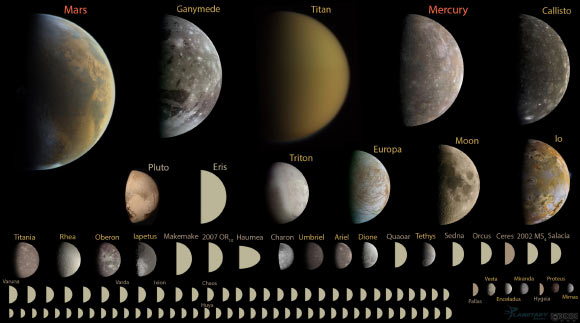Kirby Runyon, a PhD candidate in planetary geology at the Johns Hopkins University, and co-authors are proposing to rewrite the textbooks to say that the Solar System has 110 planets.

Every discovered planet in the Solar System under 10,000 km in diameter, to scale. The geophysical definition of planet includes 110 known planets. Image credit: Emily Lakdawalla, Planetary Society / K.D. Runyon et al.
Runyon and his colleagues argue for a definition of ‘planet’ that focuses on a body’s physical properties, rather than its orbital properties:
“We propose the following geophysical definition of a planet for use by educators, scientists, students, and the public:
‘A planet is a sub-stellar mass body that has never undergone nuclear fusion and that has sufficient self-gravitation to assume a spheroidal shape adequately described by a triaxial ellipsoid regardless of its orbital parameters.’
According to the team, the planet definition adopted by the International Astronomical Union (IAU) in 2006 is technically flawed.
“First, it recognizes as planets only those objects orbiting our Sun, not those orbiting other stars or orbiting freely in the galaxy as rogue planets,” the researchers explained.
“Second, it requires zone clearing, which no planet in our Solar System can satisfy since new small bodies are constantly injected into planet-crossing orbits, like NEOs near Earth.”
“Finally, and most severely, by requiring zone clearing the mathematics of the definition are distance-dependent, requiring progressively larger objects in each successive zone. For example, even an Earth sized object in the Kuiper Belt would not clear its zone.”
IAU’s 2006 formula demoted Pluto to ‘non-planet,’ thus dropping the consensus number of planets in the Solar System from nine to eight.
The new definition differs from the three-element IAU definition in that it makes no reference to the celestial body’s surroundings.
“Pluto is a planet. So is Europa, commonly known as a moon of Jupiter, and so is the Earth’s Moon, and so are more than 100 other celestial bodies in the Solar System,” said Runyon, lead author of a paper making the pro-Pluto argument that will be presented this week at the 48th Lunar and Planetary Science Conference in Texas.
“In our numerous talks with the public, we find they resonate happily with the geophysical definition we offer, especially as it is a definition reflecting a body’s intrinsic physical properties, not its location, and is a definition that leverages their intuition,” the scientists concluded.
“This definition highlights to the general public and policymakers the many fascinating worlds in our Solar System that remain unexplored and are worthy of our exploration, along with the necessary budgets.”
_____
K.D. Runyon et al. 2017. A Geophysical Planet Definition. Lunar and Planetary Science XLVIII, paper # 1448







